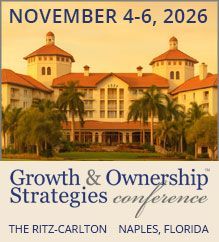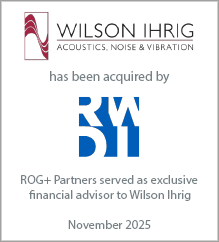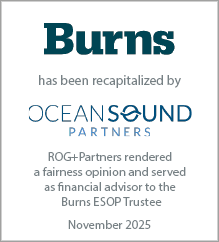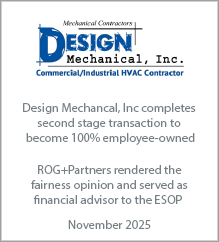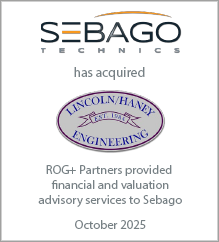Steve Gido specializes in corporate financial advisory services with a focus on mergers and acquisitions. Steve has assisted architecture, engineering, environmental consulting and construction firms of all sizes across North America achieve their growth or liquidity goals through successful mergers & acquisitions. Steve has over 15 years of investment banking experience and holds the chartered financial analyst (CFA) designation from the CFA Institute.
Five Takeaways on 2021 A/E M&A Activity
December 15, 2021
The Great Consolidation? The Great Realignment? Whatever term you want to call it, by all accounts, 2021 was a record-breaking year for A/E M&A activity. Emboldened leaders embraced and adapted all that was thrown at them – from mobilizing staff back to familiar office settings, managing a red-hot hiring and retention climate, and patiently waiting for a game-changer infrastructure package – all while deftly scooping up firms left and right and positioning themselves for a new era. One could argue our industry, with profitability levels at its pinnacle, stands at one of the most exciting and promising periods of all time. Looking ahead at the prospect of modernizing our communities, facilities, and environment for the 21st century and guided by a new generation of dynamic and diverse leaders, those organizational building blocks are scaling up and spreading out through massive consolidation.
And while this year was devoid of surprising mega-combinations among industry titans, there were indeed plenty of deals taking place between mid-sized buyers and sellers everywhere. As the year comes to a close, we'll see the number of 2021 North American transactions up 40% over 2020 levels. To be sure, Covid initially suppressed transaction appetites and volumes last year. However, we continue to be amazed just how skillfully parties have adopted new and efficient digitalization techniques along a typical M&A process, from courtship to closing.
This evolving and amalgamating industry landscape feels perhaps like beach erosion. Over a year or two, nothing appears to be that noticeable or dramatic. But when viewed over time, its impact can be understood and appreciated. With over 2,500 U.S. A/E firms sold since the end of the last recession, many venerable firms are gone. However, their additions to compatible buyers have been fundamental to our industry's growth and ownership transition needs.
Key A/E M&A takeaways include the following:
1. 2021 was a great time to sell – Many A/E owners selling today are part of that final group of Baby Boomers who have been so influential in driving M&A activity for the last 20 years. Born in the late 1950s and early 60s, they have led their organizations in recent years to solid performance but typically have not had that next generation of individuals to sell down to. That situation, combined with elevated sale multiples today for well-positioned companies, made for a perfect storm of testing the waters or engaging with eager suitors. And while no one knows precisely when and what tax changes might emerge out of Washington, DC, it's better not to risk higher capital gains rates down the road. Even though the median firm sale size this year was 25 employees, over 10 ENR 500 firms joined strategic buyers. We note many A/E firms with ESOPs sold as well.
2. Buyers of all shapes and sizes were ready to deal – Fueled by improved executive confidence and flush balance sheets, buyers were excited to get back to the M&A dance. With early retirements in force and challenging hiring conditions for 25-50-year-olds, presidents and principals understand today that talent aggregation will have to come partly from purposeful and synergistic acquisitions. Today's A/E buyers comprise a broad cross-section of companies and experiences – serial acquirers and first-time ones; traditional strategic buyers and newly hatched private equity entities; large publically traded companies and niche privately-held firms. And despite lingering challenges of international travel, nevertheless, several intriguing cross-border (U.S. to Australia and Europe) engineering and environmental transactions were consummated.
3. Capital continues to flow to the A/E industry – As I wrote in September, private equity firms continue to invest and recapitalize A/E and environmental firms at record levels. In 2021, over a dozen new platform investments have been made, with more on the horizon. Financial sponsors have grown comfortable investing in mature professional service firms and like the big picture investment themes of infrastructure renewal or ESG (Environmental, Social, and Governance). Multiple private equity firms have backed nearly every discipline in our industry – geotechnical, environmental, architecture, building envelope, civil, forensics, MEP, and transportation. Not to be outdone, the broader capital markets have enthusiastically welcomed a growing number of engineering and environmental companies that have gone the IPO route over the last two years. Many of these firms are currently trading near 52-week highs. To accelerate their growth, both the publically traded and private equity-backed firms have been the most aggressive acquirers of other A/E organizations.
4. Unfortunately, a number of these deals won't succeed – History has shown that frenetic periods of A/E merger activity are usually followed by evidence that a portion of them were just bad marriages. Publically traded companies write down goodwill, rumors, and anecdotes of team members leaving to join competitors or start new companies; or simply souring industry conditions and fluctuating client cycles that rewrite the original script. M&A deals are put together with the best of intentions and safeguards, but the reality is that putting two professional service firms together can be fragile. With so many available job openings for A/E professionals, poor integration or virtual communication, from benefit plans to career paths, can be detrimental from the start. The other concern today is buyers grossly overpaying for targets. We've seen some eyebrow-raising multiples being thrown around today with skepticism on future ROI or earnings accretion.
5. Despite our optimism, not everything looks rosy – There are just so many unknowns on what to expect coming out of such a disruptive and dramatic period like our world has experienced. We've seen speculation and price escalation across a range of asset classes (modern art, residential real estate, stock prices, cryptocurrencies), wondering how sustainable this will all be. Dormant for decades, consumer and producer price inflation is back with a vengeance. All kinds of raw material prices have soared this year. Will the robust profit margins our industry has enjoyed continue with greater wage demands? Can higher billing rates be implemented? Will rising taxes and talent shortages offset the benefits owners might receive from the new infrastructure package? Time will tell.
At ROG Partners, we possess strong relationships and years of experience navigating A/E and environmental buyers and sellers through the M&A process and towards winning combinations. Whether you are seeking to grow through acquisition or are evaluating your firm's strategic and ownership alternatives, please contact us about how we can help your organization.
We are pleased to have assisted our clients with the following recent M&A transactions: https://www.rog-partners.com/transactions.
On a final note, Season's Greetings and a happy, healthy, and prosperous New Year from all of us here at ROG!


